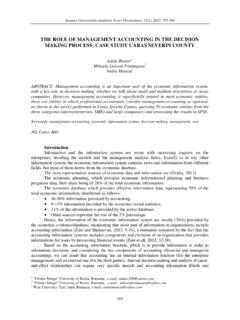Transcription of FACTORS INFLUENCING THE COMPANIES’ PROFITABILITY
1 Annales Universitatis Apulensis Series Oeconomica, 13(2), 2011. FACTORS INFLUENCING THE companies ' PROFITABILITY . Camelia Burja1. ABSTRACT: The information about company performance, especially about its PROFITABILITY , is useful in substantiating managerial decisions regarding potential changes in the economic resources that the company will be able to control in the future. This objective aims achieving superior economic results that will increase the company's competitiveness and will satisfy the shareholders' interests. The paper presents some company performance analysis models, which highlight the INFLUENCING FACTORS . The models are based on regression analysis, and the obtained results emphasize the strong connection between the PROFITABILITY of the analyzed company expresses through Return on assets and the management of available resources.
2 Key words: financial statements, regression analysis, performance, resource management JEL codes: D24, M48. Introduction At microeconomic level, performance is the direct result of managing various economic resources and of their efficient use within operational, investment and financing activities. To optimize economic results, a special attention should be given to the proper grounding of managerial decisions. These should be based on complex information regarding the evolution of all types of activities within the company. A synthetic picture of the company's financial position and its performance is found in the annual financial statements, which therefore become the main information sources that allow the qualitative analysis of how resources are used during the process of creating value. In order one company to run on a long-term performance way, it is needed to develop, implementation and maintaining the strategies, measures and coherent policies from economic and financial point of view, resulted from a good knowing of internal and external specific conditions in which the firm acts.
3 The qualities of managerial options depend by the ability of identifying those elements that productively used could lead to increasing of the results and performance. The research objective of this paper is to investigate how economic performance is achieved by companies in the industry. To reach this goal, we believed that the most appropriate indicators that express the aspects related to economic development and performance growth of companies should be chosen among the relative PROFITABILITY indicators. The empirical study of the correlations between different impact FACTORS and PROFITABILITY has been conducted by using the information taken from the annual financial reports of a company in the Romanian chemical industry for the period 1999-2009 and by using appropriate statistical techniques.
4 Starting from the economic content of rate of return and the information provided by various financial indicators computed on the basis of financial statements, the regression analysis helped identify an econometric model of economic performance assessment expressed as Return on total assets. This reflects a combination of elements that explain and influence the evolution of companies ' return, such as: the financial result, the advantageous use of the financing structure, the size of the technical and productive infrastructure, the efficiency of current assets, etc. 1. 1 Decembrie 1918 University, Faculty of Science, Alba Iulia, Romania, e-mail: 215. Annales Universitatis Apulensis Series Oeconomica, 13(2), 2011. The statistical tests performed on variables and on the overall model validate its accuracy and the opportunity of using it in the analysis of microeconomic performance and in substantiating decision-making processes related to resources' management.
5 Literature review The considerable numbers of studies that approach the performance issue at microeconomic level prove the special importance of financial management aspects, on the improvement of which depend the obtained results and the companies ' competiveness. In the case of economic agents, various methods may be used to study performance. One way to study company performance is regression analysis, which allows the modelling the functional form of dependence between various economic and financial indicators. Modelling economic performance aims to increase efficiency by improving interventions in an adaptive- learning cycle (Campbell et al., 2001). The indicators involved in the regression analysis of economic performance are numerous. Models developed to study the impact caused by the allocation and use of capital within the firm tie performance to the contribution of various resources to the increase of efficiency, expressed in terms of PROFITABILITY (Dumbrav , 2010).
6 Recent literature analyzes the PROFITABILITY of companies from various countries and economy sectors through indicators like net operating PROFITABILITY (NOP) ( Raheman et al., 2010), (Dong and Su., 2010), return on total assets (ROTA) (Deloof, 2003), (Padachi, 2006), return on invested capital (ROIC), return on assets (ROA) (Narware, 2010). In these cases, the elements considered by PROFITABILITY analysis as independent variables are financial indicators that express the working capital. PROFITABILITY at microeconomic level has been studied depending also on indicators such as current ratio, liquid ratio, receivables turnover ratio and working capital to total asset (Singh and Pandey, 2008). Other studies consider performance assessment expressed by earnings before interests and taxes (EBIT) and the associated risk resulted from the influence of using a certain financing structure (Akintoye, 2008) or expressing it though economic value added (EVA), return on equity (ROE), operating profit margin (OPM), earnings per share etc (Ryan, 2008).
7 For Romania, a few econometric performance analysis models have been used for companies listed on the Bucharest Stock Exchange. These emphasize the correlation between intangible assets and company performance expressed by annual average market price, price/earnings ratio and earnings per share (Purc rea and Stancu, 2011). Other models analyze companies ' performance on the base of correlation between net profit and cash-flow (Matis et al., 2010). Methodology for analysis the microeconomic performance To identify the functional form that describes how to increase economic performance of companies , it was started from the content of annual financial statements, of the possibilities to reflect the correlations between patrimonial elements and the conclusions of previous research. The technique used by this study is regression analysis.
8 It is considered one of the most valuable methods of establishing a conditioning between various phenomena due to its high level of generality and applicability (Albright et al., 2006). In order to select variables and appropriate performance analysis models we used the financial statements of a company in the Romanian chemical industry, representative for this sector, for the period between 1999 and 2009. The financial analysis indicators through their content express and can characterize the modality of patrimonial resources management, the conformity with the principles of a balanced functioning, options and strategies financing, the efficiency of resources used etc. From these 216. Annales Universitatis Apulensis Series Oeconomica, 13(2), 2011. financial indicators we have selected the most representative ones that exert a very strong impact on the firms' performance.
9 In order to specify the analysis model, we used as exogenous variable a series of indicators of financial analysis computed mainly as rates of the balance sheet, such as Fixed Assets Ratio, Sales to Current Assets Ration, Sales to equity Ratio, Debt Ratio, Gross Margin Return on Inventory, Expenses Revenue Ratio and structure of financing sources (Financial Leverage Ratio). For the evaluation of PROFITABILITY , Return on total assets (ROA) was used as a dependent variable. It is considered that it includes all the influences of the assets' management and it is acknowledged as a key indicator of increasing company performance; it also defines their economic growth potential (Helfert, 2002). 1. The influence FACTORS of economic performance variables The Return on Assets (ROA) indicator expresses the company's ability to generate profit as a consequence of the productive use of resources and of the efficient management, and it's used as a dependent variable in the assessment of economic performance.
10 It is computed as a ratio between Net Income and Total Assets (Burja, 2010). In following it is presented the economic significance and the calculus way for the selected variables in order to study their impact on the industrial companies ' performance. Fixed Assets Ratio (FAR) expresses the share of the assets that the company disposes of permanently for its activities and indicates the level of capital investment in the technical and productive infrastructure. A high level of this indicator means an active investment policy, but its growth over a certain level (50%) may lead to an efficient use of the working capital and it limits the ability to expand current activities. Fixed assets Fixed Assets Ratio (1). Total assets Debt Ratio (DAR) shows the extent to which the total assets of the company are funded by loans.










